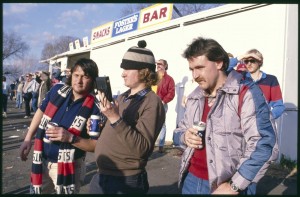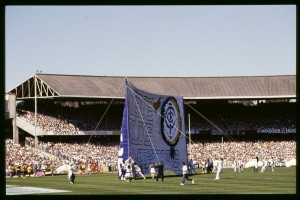Without the crowd, it would be just another game of footy.
Australian Rules has evoked a loyalty and passion amongst its supporters rarely matched in Australian sport. When the game started to become popular in the 1870s and 1880s, the crowds were an expression of leisure and of the buying power of the working man’s wage. But it was the possibility of close games and see-sawing scores that was singled out as stimulating Melburnians most directly. (1)
Large crowds were seen as early as 1880, when 13,000 people ‘paid at the gate‘ for a game between Melbourne and Carlton. By 1890 the 30,000 barrier was passed and crowds had begun to dress in scarves and various apparel in team colours…placing ribbons in hatbands and button-holes. (2)
The photos below are just a few from the Library’s Rennie Ellis Australian Rules collection;
[Anxious Essendon fans], H2010.108/348 Grand Final, H2010.108/459
Member of the Hawthorn cheer squad, H2010.108/163 and a Fitzroy (the Lions) Football supporter, H2010.108/632
Last home and away game at Junction Oval, H2010.108/552
As the game continued to grow, the fans became more involved. In the 1950s a crêpe paper run-through in club colours was placed at the end of the player’s race, like the one below. By the 1960s cheersquads would place hand-painted banners in club-colours around the fences and grandstands, some up to 200 metres long. (3) This seemingly innocuous activity was transformed in 1972 when a brawl between the Essendon and Collingwood cheer squads erupted when a member of one squad ran through the other squads’ banner. As a result, floggers, flags and run-throughs were banned by the [then] VFL.(4) Banners didn’t return until the 1980s.
[Football, Wangaratta v. Myrtleford at Benalla], H2006.100/251
[Raising the Carlton banner prior to commencement of the 1987 Grand Final], H2010.108/530
Throughout the 1980s and early 90s fans would release hundreds of balloons on Grand Final day. This has given way to acrobatic aeroplanes, rock bands, motorcades and the Grand Final sprint, performed always, for the fans.
Grand Final day, MCG, Vic., H2010.108/909
The Library holds many fantastic images of Australian Rules, including players and teams, as well as books, dvds, and the digitised Football record. For more great images of fans you might like to watch the National Film and Sound Archive video, below, of the earliest known Australian Rules footage; the 1909 Grand Final between South Melbourne and Carlton.
Bibliography
(1) Senyard, J 2005, ‘Marvellous Melbourne, consumerism and the rise of sports spectating’, Fanfare: spectator culture and Australian rules football; chapter 3, p. 33
(2) Hess, R and Nicholson, M, 2005, ‘Australian Rules football and spectator culture: runthroughs, banners and cheersquads’, Fanfare: spectator culture and Australian rules football; chapter 2, p. 12
(3) Nowick, S & Filippone, F, 1989, A run through the runthroughs: VFL cheersquads and their banners, Collins Dove, Melbourne, p. 4
(4) Ibid.
Written by Paul Dee
Librarian, Australian History and Literature

![[Anxious Essendon fans] Anxious Essendon fans watch the 1984 Grand final against Hawthorn](https://blogs.slv.vic.gov.au/wp-content/uploads/2013/09/AnxiouEssfans-199x300.jpeg)


![[Member of the Hawthorn cheer squad] A member of the official Hawthorn cheer squad watches the game.](https://blogs.slv.vic.gov.au/wp-content/uploads/2013/09/Hawthronfan-195x300.jpeg)

![[Football, Wangaratta v. Myrtleford at Benalla] A player bursts through a banner at Benalla.](https://blogs.slv.vic.gov.au/wp-content/uploads/2013/09/oldbanner-300x296.jpeg)


